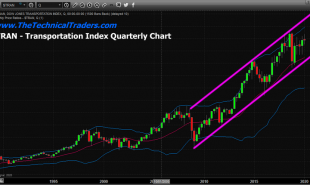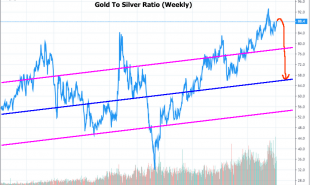
Cataclysm
Collapse generally comes as a surprise, even to those who predict it.
Via Robert Gore and Straight Line Logic
The USSR didn’t just fail one day, as does a person who dies of a sudden heart attack or stroke. It was more like a wasting illness brought on by an unhealthy lifestyle. A physician tells a morbidly obese patient: “Your daily consumption of twelve cocktails, three packs of cigarettes, and 4,000 calories, and your refusal to engage in exercise more strenuous than walking to the refrigerator will kill you, but I can’t say when.” For both individuals and governments, certain choices are incompatible with continued existence, and the Soviet government made plenty of those.
Very few people foresaw its failure when it was imminent, even purported experts. The small group who said Soviet communism wouldn’t work because it couldn’t work were disparaged right up until it didn’t work. However, the deck is always stacked in favor of those predicting this or that government will fail. Ultimately they all do because they all come to rest on a foundation of coercion and fraud, which doesn’t work because it can’t work.
There is both a quantitative and qualitative calculus for individuals subject to a government: what the government takes versus what individuals get back. Government is a protection racket: turn over your money and it promises physical security from invasion and crime, and adjudication and restitution in the event of civil or criminal wrongs. The quantitative calculus: am I getting more back than I put in? The qualitative calculus: what activities and people does the government help or hinder?
Protection rackets are often indistinguishable from extortion rackets, the “protector” a bigger threat to the “protected” than the threats against which they’re supposedly protected. Such is the case with the US government, as it was with the former Soviet government. Blessed with naturally defensive geographies and huge nuclear arsenals, the chances of the US being attacked are (or were, in the case of the former Soviet Union) remote. The cost for actual protection provided by those governments has been a tiny fraction of what’s been extracted by force or fraud from their citizenries, the very definition of an extortion racket.
Freedom militates against stupidity; coercion compounds it. Competitive markets and a wide-open intellectual climate either kill the worst ideas or impel their improvement. Power corrupts so completely because those who hold it rarely face negative feedback or consequences. Critics are mocked, stifled, imprisoned, or murdered. The costs of failure are borne by the victims. The perpetrators blame those failures on lack of funding or authority and receive more of the same.
Nothing succeeds like failure in coercive systems. Just look at the US governments “wars” on poverty, drugs, and terrorism. For rational people in free, competitive systems an ever-expanding gap between shining intentions and dismal reality prompts psychological turmoil. The powerful salve outbreaks of cognitive dissonance with arrogance, which expands apace with their failing programs. Just look at Obamacare, which its progenitor hails as his greatest accomplishment.
As the protection racket and its sub-rackets expand, the “protected” receive less and less, but pay more and more. By now, both the quantitative and qualitative calculuses are clear to productive Americans: they’re being reamed by people they despise, who in their arrogance and willful blindness despise them. The government steals trillions directly, but still resorts to financial sub-grifts—debt, fiat money, and central banking—to feed its insatiable money-lust. Like the government’s debt, stupidity compounds exponentially and rational people wonder how long unsustainable rackets can persist. The racketeers, if they realize their rackets can’t last, don’t care; they’re going to milk them as long as they can.
With the world’s most powerful military, largest nuclear arsenal, and most intrusive surveillance apparatus, the ostensible power of the US government is daunting. Yet, if a tenth of the US population ran up their debts, withdrew their funds from the financial system, and then stopped making debt service payments for a few months, it would propel a run on the banking system, choking the government’s financial lifeline and exposing its worthless fiat debt scam. Thus, the government is hardly invulnerable. As stupidity compounds, so too do its vulnerabilities.
The foundation of the global economy and financial system is interlinked debt. Anyone paying attention during the last financial crisis recognized that it took surprisingly few defaults—debt markdowns that marked down the value of the corresponding credit-assets—in a highly leveraged and interconnected system before that system unraveled and imploded. Anyone with a modicum of analytic ability and intellectual integrity realizes that the “solution” to that last financial crisis—more government and central bank debt—was another instance of stupidity compounding itself. Now, there’s more craziness in the debt asylum than there was in 2007.
There probably won’t be a voluntary debt payment moratorium, although for anyone asking how “we the people” can throw off the burdensome yoke of “our” government that would be a fine place to start. There doesn’t have to be; the mechanics of debt implosion guarantee the same result. Most of the world’s financial assets are debt or equity claims. Equity has a lower legal right to a debtor’s assets than debt. A debt collapse will leave the world impoverished, and so too its governments. Many real assets will be tied up in creditors’ squabbles. Governments’ and their central banks’ vaunted abilities to drive interest rates to subzero, go further into debt, and exchange their pieces of paper or computer entries for other pieces of paper or computer entries will mean little in a world submerged in debt, worthless paper and computer entries.
Those who scoff at the notion of cataclysmic collapse ignore ubiquitous signs of deterioration and recent history. Real economic growth and incomes have been trending downward since the turn of the century, even by official statistics. One has to question how much of the growth in either is the product of statistical legerdemain—government statistics leave much to be desired—and debt. If debt grows at 5 percent and the economy and incomes grow at 2, is the economy actually growing? Should some present value accounting be made of the fact that the longer debt growth exceeds economic growth, the greater the burden that debt imposes on the economy?
Some say the last financial crisis proved that governments and central banks can prevent a debt implosion. They’re drawing the wrong conclusion. It “proved” that massive injections of fiat debt defibrillated the patient, and it still serves as essential life support. However, not even life support will keep the patient alive the next time the EKG flatlines. All governments will then have are lots of weapons, worthless debt, millions of angry beneficiaries, and whatever loyalty they can still command, literally, from the police-military-surveillance complexes.
At which point, the calculus becomes intolerable for those long milked and bilked by governments, and offering them only further pain with no gain. Inevitably, they will consider their options: flight, secession, devolution, or revolution. Governments are only temporary arrangements and pendulums swing. Cataclysm should afford, for those inclined, opportunities—if they’re willing to fight for them—to live under arrangements more conducive to individual freedom and voluntary interaction.
Read more by MarketSlant Editor







